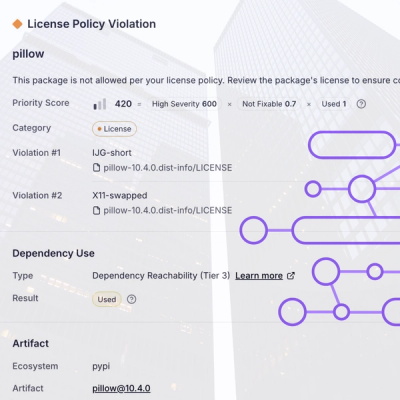
Research
/Security News
Critical Vulnerability in NestJS Devtools: Localhost RCE via Sandbox Escape
A flawed sandbox in @nestjs/devtools-integration lets attackers run code on your machine via CSRF, leading to full Remote Code Execution (RCE).
Simplex Noise implementation offering 1D, 2D, and 3D forms. Based on work by Heikki Törmälä (2012) and Stefan Gustavson (2006). Core algorithm designed by Ken Perlin (2001). This library provides 1D, 2D, and 3D simplex (coherent) noise, which is useful for procedural content generation - for example, terrain and particles in game development or visual media in movies. Compared to classic Perlin noise, simplex noise has no noticable directional artefacts, and has a well-defined and continuous gradient. This means content will be visually smoother, with a lower computational complexity especially at higher orders.
Simplex Noise implementation offering 1D, 2D, and 3D forms w/ values in the range of 0 to 255. Based on work by Heikki Törmälä (2012) and Stefan Gustavson (2006). Core algorithm designed by Ken Perlin (2001).
This library provides 1D, 2D, and 3D simplex noise, which is useful for procedural content generation - for example, terrain and particles in game development or visual media in movies. Compared to classic Perlin noise, simplex noise has no noticable directional artefacts, and has a well-defined and continuous (coherent) gradient. This means content will be visually smoother, with a lower computational complexity especially at higher orders.
Computations use the following r^2 values to determine kernel contribution:
| Order | Value |
|---|---|
| 1D | 1.0 |
| 2D | 0.5 |
| 3D | 0.6 |
Classic noise has problems with non-uniformity throughout its domain of definition, particularly for 2D planar slices of 3D and 4D noise, it has visible axis-aligned artefacts, it is expensive to compute for 4D and up, and its derivative in 3D and 4D is a very complicated high order polynomial.
Simplex noise is several times faster to compute, particularly for 4D and up, it does not have nearly as many visual problems with non-uniformity and axis-aligned artefacts, and it has a simple polynomial derivative everywhere, even for higher dimensions.
Simplex noise looks better, but different, and is thus visually incompatible with classic Perlin noise. The difference in feature size and range of values can easily be compensated for by a few simple scaling multiplications, but the different visual character might change the visual result of shaders that depend heavily on one or two components of noise. (Fractal sums of several noise components should still look about the same, though.)
Simplex.Noise.Seed = 209323094; // Optional
int length = 10, width = 15;
float scale = 0.10f;
float[,] noiseValues = Simplex.Noise.Calc2D(length, width, scale);
FAQs
Simplex Noise implementation offering 1D, 2D, and 3D forms. Based on work by Heikki Törmälä (2012) and Stefan Gustavson (2006). Core algorithm designed by Ken Perlin (2001). This library provides 1D, 2D, and 3D simplex (coherent) noise, which is useful for procedural content generation - for example, terrain and particles in game development or visual media in movies. Compared to classic Perlin noise, simplex noise has no noticable directional artefacts, and has a well-defined and continuous gradient. This means content will be visually smoother, with a lower computational complexity especially at higher orders.
We found that simplexnoise demonstrated a not healthy version release cadence and project activity because the last version was released a year ago. It has 1 open source maintainer collaborating on the project.
Did you know?

Socket for GitHub automatically highlights issues in each pull request and monitors the health of all your open source dependencies. Discover the contents of your packages and block harmful activity before you install or update your dependencies.

Research
/Security News
A flawed sandbox in @nestjs/devtools-integration lets attackers run code on your machine via CSRF, leading to full Remote Code Execution (RCE).

Product
Customize license detection with Socket’s new license overlays: gain control, reduce noise, and handle edge cases with precision.

Product
Socket now supports Rust and Cargo, offering package search for all users and experimental SBOM generation for enterprise projects.